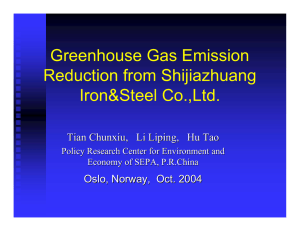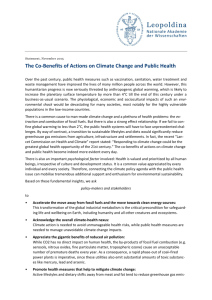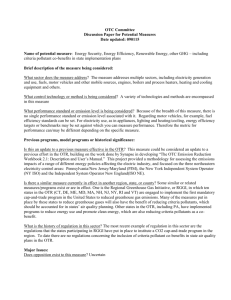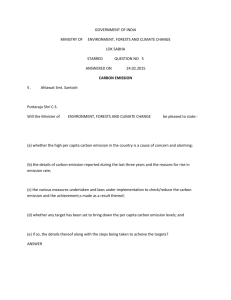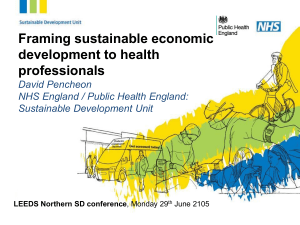Greenhouse Gas Emission Reduction from Shijiazhuang Iron&Steel Co.,Ltd.
advertisement
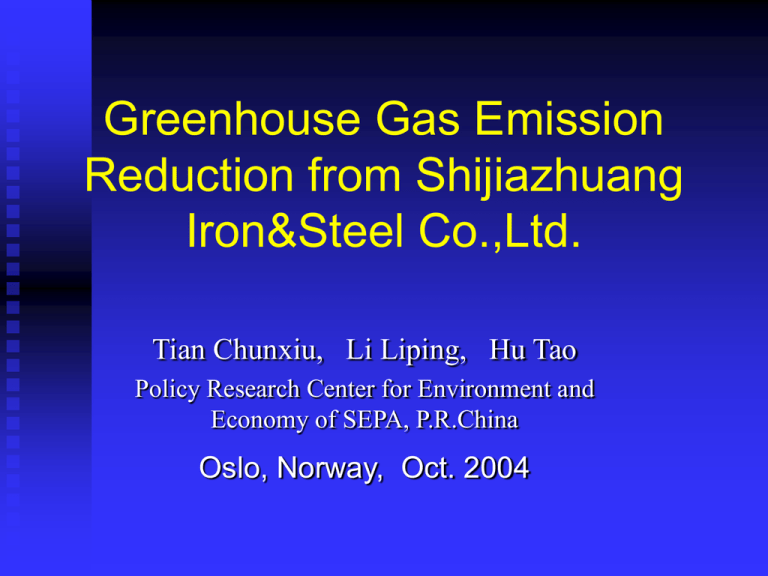
Greenhouse Gas Emission Reduction from Shijiazhuang Iron&Steel Co.,Ltd. Tian Chunxiu, Li Liping, Hu Tao Policy Research Center for Environment and Economy of SEPA, P.R.China Oslo, Norway, Oct. 2004 Contents 1 Background and General Information 2 GHG Emission 3 Cleaner Production and Energy Efficiency(CP-EE) Options and Its Co-benefits 4 Policy Implications 1 Background and General Information 1.1 Background 1.2 General Information 1.1 Background Part of UNEP GERIAP(Greenhouse Emission Reduction from Industry in Asia and the Pacific) project (9 countries participate, 5 plants each country, including 4 energy intensive sectors: Cement&Lime, Paper, Iron&Steel, Chemicals) Objective of the project: Encourage industry to reduce greenhouse gas emissions and costs by improving its energy efficiency. Funded by SIDA Duration: 3+years until 2005 GERIAP countries Mongolia China Philippines Vietnam Thailand India Bangladesh Sri Lanka Indonesia GERIAP sectors selected on energy use Cement & Lime Iron & Steel Chemicals (fertilizer, plastics, etc.) Pulp & Paper Five Case Plants in China Shijiazhuang Steel Company Ltd. Anhui Linquan Chemical Industrial Co. Ltd. Anhui Tian Du Paper Co. Ltd. Tianjin Zhengxin Cement Plant Yuanping Municipal Chemical Industrial Co. Ltd. CP-EE Methodology Step 1: Plan and organise • • • • Establish CP-EE Team Collect macro data List process steps and inputs/outputs Determine audit focus Step 2: Analyse process with energy interaction • • • • Prepare process flow charts Collect baseline data Materials and energy balance Assign costs to materials, energy, waste • Identify CP opportunities for energy use and materials, water and wastes (indirect energy use) Step 4: Carry out feasibility analysis • • • • Assess technical feasibility Assess financial feasibility Assess impact on greenhouse gas emissions Select feasibility options for implementation Step 5: Implement and monitor • • Plan and implement Monitor and evaluate results Step 6: Sustain CP-EE programme • Repeat CP-EE assessment Step 3: Generate CP options 1.2 General Information Year of establishment: 1957 Location: Shijiazhuang city, Hebei Province Number of employees: 8300 Working shifts / hours: 3 shifts/8 hours Annual production: 1.63 million ton(steel) (Year of 2003) Environmental management Production Process Description 2 GHG Emission Methodology from IPCC GHG Calculator: Methodology Raw Data Conversion Aggregation Normalisation Fuel use Electricity use Industrial process Transport GHG emissio n factor Total GHG emission s Normalised GHG emissions 2 GHG Emission(Cont.) Table 1 CO2 Emissions in 2003 Items tCO2 Fuel Combustion 363,671 Electricity 573,349 Road Transport Total 10,208 947,227 2 GHG Emission(Cont.) CO2 Emission Profile by Items in 2003 1% 38% Fuel Combustion Electricity Road Transport 61% 3 CP-EE Options and Its Co-benefits 3.1 Three focus areas 3.2 CP-EE Options 3.3 Several CP-EE Options and Its Co-benefits 3.1 Three Focus Areas Focus area 1: incandescent lamps Focus area 2: The converter furnaces----key process and high energy consumption compared to other areas Focus area 3: The cooling water tower---- water and wastewater are very critical issues on site. 3.2 CP-EE Options Focus area options 1 incandescent lamps incandescent lamps 2 The converter furnace Cogeneration to produce steam and electricity 3 Build steam accumulator 4 Use of the wasted steam for electricity generation 5 Steam leak survey and repair 6 Reduce nitrogen consumption 7 Reduce oxygen consumption 8 Reduce compressed air consumption 9 10 The cooling water tower Establish water balance & ensure water meter functioning normally Change roof deck fan operating procedure or install VSD motor 11 Biocide dosing injection pump 12 Increase cycles of concentration 13 Change water testing and monitoring equipment calibration procedures 3.3 Several CP-EE Options and Its Co-benefits Option 1: incandescent lamps(offices, meeting rooms, toilets, change-rooms, corridors) replaced by lamps of energy-saving 6000 lamps 60 watt/lamp 8 hours/day 365days=1,051,200 kWh 6000 lamps 15 watt/lamp 8 hours/day 365days=262,800 kWh =788,400kWh 3.3 Several CP-EE Options and Its Cobenefits(Cont.) Estimated Benefits: Cost savings: 788,400kWh 0.45RMB/kWh-6,000 lamps8RMB/lamp=306,780RMB CO2 Emission Reduction: 788400kWh 0.772tCO2/kmh=609t Other air pollutants emission reduction ! Considering the total electricity use in 2003 was 742,680,000kWh, how large potential co-benefits are existing in China! 3.3 Several CP-EE Options and Its Cobenefits(Cont.) Option 2: Build steam accumulator Description: The steam system is designed to a maximum operating pressure of 24.5 kg/cm2, it operates at about 6-8 kg/cm2. This is due to old and corroded pipe work that causes leaks in the cooling water piping, especially the furnace’s hood cooling water loop. As a result, 500-600 tonnes of clean steam is vented each day. The option is to build a steam accumulator on the converter furnace, using the company’s cogeneration boiler to accumulate heat from the surplus steam from the current converter furnace to stabilize its pressure, and it applies to the converter furnace, electric furnace and VD furnace. 3.3 Several CP-EE Options and Its Cobenefits(Cont.) Estimated Benefits Annual cost savings: RMB 7.4 million Annual environmental savings 148,000 ton soft water saved per year Greenhouse Gas Emissions Indirect reduction of CO2 emissions. 3.3 Several CP-EE Options and Its Cobenefits(Cont.) Barriers of benefits: finances Options compared(to be done) 4 Policy Implications Co-benefits for China are very significant and not to be ignored. China has huge potential CDM market, like Shijiazhuang Iron&Steel Co. Ltd. (Interim Measures for Operation and Management of Clean Development Mechanism Projects in China, KP will be effected) Considering co-benefits, environmental management policy and climate change policy should be combined. Main energy intensive sectors, such as cement, iron&steel, paper, chemicals, should be paid attention to in the researches on co-benefits . Methodology----SIA (to be discussed) For Sustainable development Environ ment Social Economic Overall Analytical Framework of SIA on policy implications of co-benefits Economic Impacts Social Impacts Environmental Impacts Short term Impacts Long term Impacts Direct Direct Indirect Indirect Stages The SIA methodology has four main stages, each of which places emphasis on consultation with outside experts and the public. Screening and Scoping Impact Assessment Assessment of Alternative Mitigation and Enhancing (Flanking) Measures Monitoring and Post-Evaluation Key Key Sustainability Indicators Thank you!
